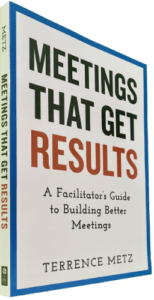Is it easy for you to build collaboration, commitment, and participation in meetings? Then feel free to walk away from this article.
If, however, you’re like most people, leading groups and teams toward a common goal, either remotely or in person, is challenging. For many leaders, it is their biggest challenge. While we can’t solve all your leadership problems in one article, these next four topics are easily worth five minutes of your time.
 Build collaboration while satisfying individual needs
Build collaboration while satisfying individual needs- How to create and sustain a participatory environment
- Securing collaboration among multi-discipline workgroups
- “The distribution of collaborative work is often extremely lopsided . . .”
How to build collaboration while satisfying individual needs
In the song, Garden Party, Ricky Nelson wrote, “You see, ya can’t please everyone, so ya got to please yourself.” Yet in meetings, in order to build collaboration, you must also satisfy individual needs. So how do you accomplish this? Below are some tried and true suggestions/rules (Along with links to more in-depth articles on tools and techniques, when appropriate.) which, in our own leadership experience, we’ve found helpful. Feel free to compare these suggestions with your own experience. Let us know when you identify some things that work particularly well at building collaboration, or some things that fail. (Listed not in order of importance or chronology)
- Avoid personal attacks or comments by keeping your critiques and challenges about the entire group.
- Make the reasons behind differing views more evident. Conflict is healthy when you know how to manage it.
- Encourage cohesiveness with more group activities permitting richer interaction among participants.
- While lookbacks, after-action reviews, or other reviews of group performance generate healthy learnings that improve future performance – if you want to alienate an individual, be sure to mention him or her by name. (i.e. DO NOT mention individuals in look-backs or after-action reviews.)
- Limit your meeting size to five to nine people, large enough to accomplish anything but not so large as to waste an individual’s time.
- From the outset, ensure that everyone understands and values your meeting deliverables.
- At the wrap, ensure that all roles, responsibilities, and next steps are clear and acceptable to all.
- Maintain neutrality. As the leader or facilitator, maintain vigilant neutrality and avoid introducing personal thoughts or claims.
How to create and sustain a participatory environment
To build collaboration, the facilitator must first protect the participants. Secondarily, the facilitator must help drive the group toward its desired deliverable. Thus, both people and issues are managed by creating an environment that is participatory and conducive to productivity. Easier said, than done. It’s tough to build collaboration unless you:
- Demonstrate effective communication skills
- Develop rapport with participants
- Practice active listening
- Demonstrate ability to observe and provide feedback
Since there is no ‘silver bullet’ to be an effective facilitator, show up prepared. Apply a variety of preparatory devices including conversations with your participants before the session starts. How else will you understand them and the best method to serve them?
Once they are valued and understood, improve your selection of tools to use. Make it easier for them to reflect on what you have captured so that they can easily confirm the accuracy or make corrections and additions as appropriate.
When in-person and providing feedback and reflection, scan the room (or, if it’s a virtual meeting, the participants on your computer screen) and observe reactions, typically non-verbal. Determine if the group understands and agrees, or if there is resistance due to misinterpretation or misunderstanding that you can help clear up.
The “zen” of the experience advises us that participants respond to stimuli differently. Not everyone responds effectively to a strictly “verbal” (i.e., narrative) environment. Psychologist Howard Gardner identified multiple types of intelligence. He claims that all humans have the spark of genius buried within, but they manifest differently among us. The original types include:
- Bodily-Kinesthetic Intelligence (“Body Smart”)
- Interpersonal Intelligence (“People Smart”)
- Intra-personal Intelligence (“Self Smart”)
- Linguistic Intelligence (“Word Smart”)
- Logical-Mathematical Intelligence (“Number/ Reasoning Smart”)
- Musical Intelligence (“Musical Smart”)
- Naturalist Intelligence (“Nature Smart”)
- Spatial Intelligence (“Picture Smart”)
Securing collaboration among multi-discipline workgroups
Groups separated by geography are but one challenge. So, here are tips for how to build collaboration among multi-discipline work groups. Apply these tips when facilitating among work groups that are widely separated by geography.
Frequent Interaction Among Multi-Discipline Work Groups
Very often, a workgroup comprises several small teams, each in separate locations. Successful teams require cross-functional support, integrating their efforts frequently. Regular and frequent interaction across functions provides numerous benefits. Interaction establishes mutual commitment among multi-discipline work groups. Integration also creates a common repository of knowledge.
Exchange People Within Multi-Discipline Work Groups
Typically, a team in one country has all the necessary technical capabilities, but their “requirements” come in large batches of written documents developed many time zones away. Predictably, when an application is finished several weeks or months after the arrival of the requirements, it isn’t what the customers really want. Large separations between customers or analysts and the implementation team seldom work very well. Therefore, consider relocating a couple of people from one team to the other team for extended periods of time, preferably on a rotating basis. One or two team members who understand customer needs could be located with the development team, or alternatively, one or two people who are part of the development team could be located closer to customers. Rotating people through these positions proves to be highly effective.
Daily Proxy For Multi-Discipline Work Groups
Sometimes dispersed teams communicate through a single person. Someone from each site becomes a member of the core team and serves as a proxy for the remainder of their remote team members. The proxy assumes responsibility for a large amount of well-defined work and sends it to the remote team, calling them daily to describe what needs to be done, answer questions, and retrieve completed work. Thus, the remote team maintains rich communication with one person on the core team, and the core team considers the remote team an extension of this proxy, who can help manage work for several people.
Traveling Leader Supporting Multi-Discipline Work Groups
Consider an oobeya or “war room” with big visible charts showing project status and issues. Maintain identical status charts in each of multiple rooms around the world. The program leader should travel from one room to another, holding regular status meetings at each location. Other locations may call into where the leader is hosting the meeting. Leadership commitment reinforces the mutual commitment of all teams to their common objective.
Caution Among Multi-Discipline Work Groups
Participants may develop the perception that one group is better than the other. For example, when part of a team relies heavily on a different language, when one group represents subcontractors while another represents the contracting company, or when one group clearly has higher pay or status than the other. Such perceptions quickly destroy the respect, trust, and commitment that are essential for true teamwork. To avoid the perception, or fix the situation, enforce the suggestions above with more people on rotation, more rotations, daily updates, and a leader who facilitates frequently at all locations, not solely the home-based site.
Success in complex organizations depends increasingly on the leadership’s ability to build collaboration. No one person has all the answers. Yet according to Harvard Business Review, over the past two decades, the amount of time managers and employees spend on collaborative work has ballooned. At many companies, people now spend about 80 percent of their time in meetings or answering colleagues’ requests.
Imagine that we could improve the productivity of meetings by only five percent.
In other words, reduce meeting time by three minutes per hour, with comparable outputs. What would that be worth in your organization? What would that be worth to you personally over the future of your career? For the average individual, we are talking about hundreds of thousands of dollars.
Seven tips to build collaboration and collaborative work:
- Demand an articulate and written explanation of the meeting purpose, scope, deliverables (i.e., objectives), and simple agenda BEFORE the meeting begins. If someone needs you to attend, then you have every right to show up prepared.
- Encourage the use of ground rules. A group of people multitasking on laptops and cell phones will waste more of YOUR time, than anything else.
- Keep the leader on task. Don’t allow the leader or group to ramble on without focus. Once focus is established, do not permit scope creep. Remind everyone about the question or topic at hand. Most scope creep involves discussions outside the scope of the meeting, such as “Why are we doing this in the first place?”
- Capture solid notes, especially about decision points and outputs. Make the outputs clear, especially when the leader is doing a poor job of writing things down, and presumes to be relying on memory after the meeting to set up a record.
- Challenge other participants to make them defend themselves. Request examples, evidence, and proof of their claims. Discover under what conditions they may be right, and under what conditions they may be wrong.
- Seek out the objective measurement for modifiers (e.g., adjectives and adverbs). If someone wants “quality”, seek a better understanding of how to measure it. To one person, a bowl of curry may be spicy but to another person, it’s not. Seek out the unit of measurement (Scoville Units) to help them reach agreement.
- Ask people what they are going to tell their supervisors and peers when the meeting is over about what was accomplished during the meeting. Strive to ensure that it sounds like all the participants were in the same meeting.
Chief Collaboration Officers
Granted, much of the suggested material above is the responsibility of the session leader. But if they won’t do it, you better. Remember, it’s worth thousands and thousands of dollars to promote more collaborative work. Harvard Business Review states further that collaboration may answer many of your biggest business challenges. They encourage leaders to promote collaborative work and teamwork, and suggest . . .
“. . . we believe that the time may have come for organizations to hire chief collaboration officers.”
______
Don’t ruin your career by hosting bad meetings. Sign up for a workshop or send this to someone who should. MGRUSH workshops focus on meeting design and practice. Each person practices tools, methods, and activities daily during the week. Therefore, while some call this immersion, we call it the road to building high-value facilitation skills.
Our workshops also provide a superb way to earn up to 40 SEUs from the Scrum Alliance, 40 CDUs from IIBA, 40 Continuous Learning Points (CLPs) based on Federal Acquisition Certification Continuous Professional Learning Requirements using Training and Education activities, 40 Professional Development Units (PDUs) from SAVE International, as well as 4.0 CEUs for other professions. (See workshop and Reference Manual descriptions for details.)
Want a free 10-minute break timer? Sign up for our once-monthly newsletter HERE and receive a free timer along with four other of our favorite facilitation tools.
Go to the Facilitation Training Store to access proven, in-house resources, including fully annotated agendas, break timers, and templates. Finally, take a few seconds to buy us a cup of coffee and please SHARE with others.
In conclusion, we dare you to embrace the will, wisdom, and activities that amplify a facilitative leader. #facilitationtraining #MEETING DESIGN
______
With Bookmarks no longer a feature in WordPress, we need to append the following for your benefit and reference
- 20 Prioritization Techniques = https://foldingburritos.com/product-prioritization-techniques/
- Creativity Techniques = https://www.mycoted.com/Category:Creativity_Techniques
- Facilitation Training Calendar = https://mgrush.com/public-facilitation-training-calendar/
- Liberating Structures = http://www.liberatingstructures.com/ls-menu
- Management Methods = https://www.valuebasedmanagement.net
- Newseum = https://www.freedomforum.org/todaysfrontpages/
- People Search = https://pudding.cool/2019/05/people-map/
- Project Gutenberg = http://www.gutenberg.org/wiki/Main_Page
- Scrum Events Agendas = https://mgrush.com/blog/scrum-facilitation/
- Speed test = https://www.speedtest.net/result/8715401342
- Teleconference call = https://youtu.be/DYu_bGbZiiQ
- The Size of Space = https://neal.fun/size-of-space/
- Thiagi/ 400 ready-to-use training games = http://thiagi.net/archive/www/games.html
- Visualization methods = http://www.visual-literacy.org/periodic_table/periodic_table.html#
- Walking Gorilla = https://youtu.be/vJG698U2Mvo

Terrence Metz, president of MG RUSH Facilitation Training, was just 22-years-old and working as a Sales Engineer at Honeywell when he recognized a widespread problem—most meetings were ineffective and poorly led, wasting both time and company resources. However, he also observed meetings that worked. What set them apart? A well-prepared leader who structured the session to ensure participants contributed meaningfully and achieved clear outcomes.
Throughout his career, Metz, who earned an MBA from Kellogg (Northwestern University) experienced and also trained in various facilitation techniques. In 2004, he purchased MG RUSH where he shifted his focus toward improving established meeting designs and building a curriculum that would teach others how to lead, facilitate, and structure meetings that drive results. His expertise in training world-class facilitators led to the 2020 publication of Meetings That Get Results: A Guide to Building Better Meetings, a comprehensive resource on effectively building consensus.
Grounded in the principle that “nobody is smarter than everybody,” the book details the why, what, and how of building consensus when making decisions, planning, and solving problems. Along with a Participant’s Guide and supplemental workshops, it supports learning from foundational awareness to professional certification.
Metz’s first book, Change or Die: A Business Process Improvement Manual, tackled the challenges of process optimization. His upcoming book, Catalyst: Facilitating Innovation, focuses on meetings and workshops that don’t simply end when time runs out but conclude with actionable next steps and clear assignments—ensuring progress beyond discussions and ideas.




